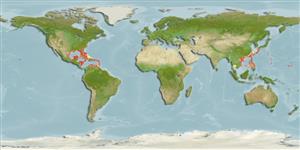Common names from other countries
Environment: milieu / climate zone / depth range / distribution range
Ecología
marino asociado a arrecife; no migratorio; rango de profundidad 5 - 80 m (Ref. 9626), usually 5 - 30 m (Ref. 9626). Subtropical; 35°N - 10°N
Western Atlantic: Bermuda and Florida, USA to French Guiana, including the Gulf of Mexico and the Caribbean Sea.
Tamaño / Peso / Age
Maturity: Lm ? range ? - ? cm
Max length : 8.0 cm TL macho / no sexado; (Ref. 9710)
Espinas dorsales (total) : 14 - 15; Radios blandos dorsales (total) : 15 - 16; Espinas anales: 3; Radios blandos anales: 17. Deep blue, the head and chest orange-yellow; a narrow blue ring around eye; a small dark blue smudge just behind corner of mouth; pectoral fins pale yellowish; other fins deep blue with pale blue margins (Ref. 13442).
Normally occurs in rubble areas. Feeds on various types of algae. Oviparous (Ref. 205), monogamous (Ref. 52884). Retreats into holes when frightened (Ref. 9710). Has been reared in captivity (Ref. 35408).
Life cycle and mating behavior
Maturities | Reproducción | Spawnings | Egg(s) | Fecundities | Larva
Oviparous, distinct pairing (Ref. 240). Monogamous mating is observed as both facultative and social (Ref. 52884).
Allen, G.R., 1985. Butterfly and angelfishes of the world. Vol. 2. 3rd edit. in English. Mergus Publishers, Melle, Germany. (Ref. 4858)
IUCN Red List Status (Ref. 130435)
CITES (Ref. 128078)
Not Evaluated
Threat to humans
Harmless
Human uses
Pesquerías: comercial; Acuario: Comercial
Herramientas
Special reports
Download XML
Fuentes de Internet
Estimates based on models
Preferred temperature (Ref.
115969): 23.5 - 28.1, mean 26.1 (based on 324 cells).
Phylogenetic diversity index (Ref.
82804): PD
50 = 0.5000 [Uniqueness, from 0.5 = low to 2.0 = high].
Bayesian length-weight: a=0.03090 (0.01359 - 0.07026), b=2.89 (2.70 - 3.08), in cm Total Length, based on LWR estimates for this (Sub)family-body shape (Ref.
93245).
Nivel trófico (Ref.
69278): 2.0 ±0.0 se; based on diet studies.
Resiliencia (Ref.
120179): Alto, población duplicada en un tiempo mínimo inferior a 15 meses (Preliminary K or Fecundity.).
Fishing Vulnerability (Ref.
59153): Low vulnerability (10 of 100).
